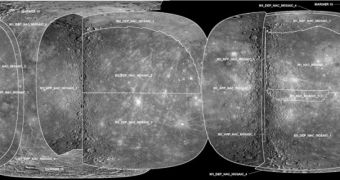Astronomers can now boast the creation of the first complete map of Mercury, the closest planet to the Sun inside our solar system. A large collection of images, gathered by space probes, telescopes and other observatories, went into the creation of the new map, which is the first one to contain all notable features on the surface of the planet. The achievement was unveiled at the annual meeting of the American Geophysical Union (AGU), on Tuesday.
The photos used in the map date as far back as the 1970s, when the Mariner 10 space probe first imaged the surface of Mercury directly. Observations from the three flybys that NASA's new spacecraft, the MErcury Surface, Space ENvironment, GEochemistry and Ranging (MESSENGER), did around the celestial body were also included. Though fanned over a number of years, the last of the flights took place on September 29, 2009, when the instruments on the probe imaged the last of the “gray areas” that were skipped during previous missions, Wired reports
The map itself was constructed by experts at the United States Geological Survey (USGS). They had a very difficult job in doing this, mostly because the 917 photographs they used were all taken at different resolutions and in different lighting conditions. To compensate for this flaw, and create the apparently seamless representation of Mercury's surface, the experts had to use highly advanced computer software. These programs allowed them to identify the landscape features in each of the images, and then modify the photos so that they looked roughly the same.
MESSENGER was launched in 2004, and it had to undergo a fairly complex procedure before orbital insertion could be achieved. This is evidenced by the seven years that will have passed by 2011, when the final stage of the mission is scheduled to begin. After it took off, from the Space Launch Complex 17-A, at the Cape Canaveral Air Force Station, in Florida, MESSENGER had to perform one Earth swing and two Venus swings before gathering enough speed to enter its correct path for the three flybys. Now, after the final one is done, the craft is set on a course that will take it to orbit in about two years.

 14 DAY TRIAL //
14 DAY TRIAL //